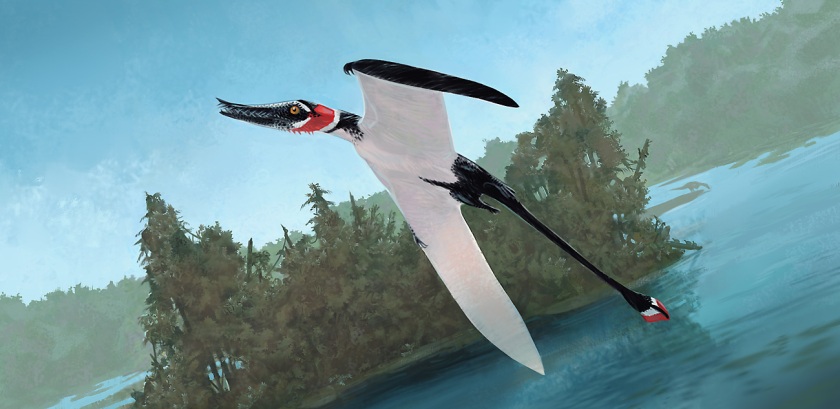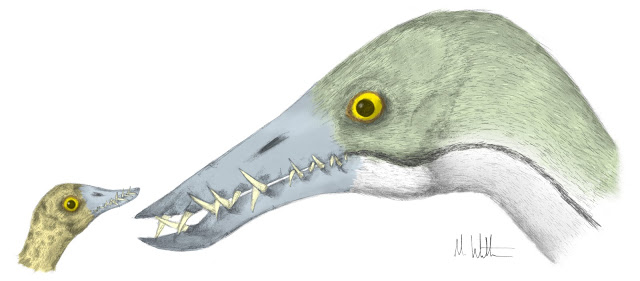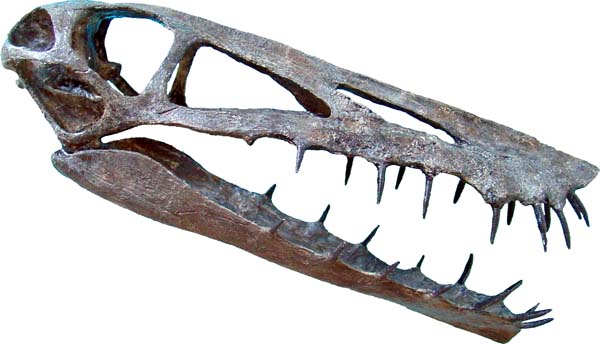
Between the age of the giant campylagnathoidids in the Early Jurassic and the quick radiation of pterodactyloids in the Late Jurassic, the Jurassic pterosaur faunas were dominated by one group of pterosaurs. Rhamphorhynchidae is best known for it’s Solnhofen genus, Rhamphorhynchus itself, which has been immortalised as the most iconic non-pterodactyloid. Rhamphorhynchidae, however, was very far from monophyletic, and indeed these pterosaurs were such an evolutionary success that they replaced all but two other contemporary clades, one of which returning the favour by the Cretaceous.
Rhamphorhynchidae is usually divided in two clades: the conical snouted Rhamphorhynchinae, and the deep snouted Scaphognathinae. However, such superficial distinctions seem to not be accurate (the deep snouted Sericipterus seems to be the sister taxon to the more conical snouted Angustinaripterus, for instance), and a complete restructuring of Rhamphorhynchidae isn’t unlikely. The clade first appeared in the Early Jurassic, and lasted as recently as the beginning of the Cretaceous.
Rhamphorhynchids are generally considered to be the sister clade to Monofrenestrata, to the point that it has been suggested a paraphyletic state, with forms akin to Pterorhynchus being ancestral to wukongopterids. Currently, however, such notions are not widely supported. In some ways, rhamphorhynchids are to pterodactyloids what enantiornithes are to ornithurine birds, having found remarkably different solutions to the same problems. Whereas pterodactyloids drastically reduced their tails, rhamphorhynchids made their’s robust steering instruments; whereas pterodactyloids fused their nostrils and antorbital fenestrae to form large weight-saving and skull expanding nasoantorbitals, rhamphorhynchids generally reduced their fenestrae, relying on less conspicuous penumacy instead; whereas pterodactyloids had massive, ungulate-like metacarpals, the rhamphorhynchid ones were proportionally much smaller. Likewise, rhamphorhynchid heads are also not ridiculously massive, and the oval torso not ridiculously small. They lack a notarium and their sternums are generally nor particularly deep; however, they were no less endowed in terms of flight muscles. Instead of the generally small claws of the pterodactyloids, rhamphorhynchids display curved, robust claws, optimal for climbing and for predation. Still, it is very likely that their different adaptations placed them at disadvantage against the pterodactyloids, given the relatively quick ecological displacement.
Biology

A lot of what we known about the pterosaur life cycle comes from german Rhamphorhynchus fossils. Many named species of Rhamphorhynchus turned out to be flaplings, being a good example of pterosaurian precociality, and the resulting multiple ecological niches taken by the animals across their lifetimes. However, Rhamphorhynchus also provided possible evidence of parental care, with the juveniles being poor flyers for a period of time after hatching. The juveniles have big eyes and short snouts, characteristics often associated with animals that display parental care (those are the “cuteness” markers, after all), though they work just as easily as adaptations for aerial insect hunting. Indeed, the changes in teeth, becoming shorter and thicker as the animals grew, also indicate a change of diet, from insects to vertebrates. The Solnhofen fossil reccord is so precise that it is possible to tell the age at which the animals had their bones completly fused, at precisely one year of age.
Also based on Rhamphorhynchus‘ german fossils, we know that non-pterodactyloid pterosaurs are a perfect example of a “primitive” endothermic lifestyle. While considerably faster, Rhamphorhynchus‘ growth rate was similar to that of crocodyllians: the animals had a fast growth rate for the first year of life, before slowing down. By sexual maturity at two years of age, the animal would still keep growing until several years later. This is a high contrast to pterodactyloids, which while [super]precocial still had growth rates closer to those of birds and mammals.
Rhamphorhynchus itself was a piscivorous pterosaur, probably analogous to modern fishing bats in terms of lifestyle. It was far less adapted to take off from the water than pterodactyloids, so it must have caught it’s prey on the wing using it’s specialised teeth and hooked jaw tips, representing in some ways the “classical pterosaur”. Like fishing bats, it might also have hunted at night, avoiding competition from other pterosaurs that way (though no other specialised piscivore is known from Solnhofen’s pterosaur fauna). Meanwhile, the other Solnhofen rhamphorhynchid, Scaphognathus, was seemingly diurnal.
However, while some other rhamphorhynchids like Nesodactylus were specialised piscivores as well, most members of the clade were found in inland ecosystems. This, combined with the deep jaws and more spike-like teeth of the “scaphognatines”, makes it clear that most rhamphorhynchids were terrestrial predators of small mammals, lepidosaurs, small dinosaurs and the occasional pterosaur.

The inland species, in contrast to the long winged Rhamphorhynchus, have rather comparatively short wings, further suggesting their specialisation for terrestrial raptorial habits. The largest of all rhamphorhynchids, Harpactognathus, seems to have been a rather nasty piece of work: with a wingspan of 2.5 meters, it was the second largest non-pterodactyloid pterosaur to have ever lived. With a robust skeleton and powerful, almost crocodillian jaws (fenetrae nonwithstanding), this was the Morrison Formation’s eagle.

That said, modern flying foxes also have sharp teeth. While angiosperms were at best very rare during the rhamphorhynchid golden age, species adapted to feed on gyngko or podocarp fruits are quite plausible.
Success and demise
Rhamphorhynchids, as said before, appeared in the Early Jurassic, and in the Middle of the epoch they replaced the campylognathoidids as the dominant pterosaurs. Their surpremacy of aerial tetrapod niches reached such a level that the only other pterosaur clades present at their peak were the anurognathids and monofenestrates, represented at first by the wukongopterids. Both lineages were comparetively less diverse: anurognathids were mostly small nocturnal aerial insectivores while wukongopterids were generalists that, while speciose, were seemingly restricted to Asia. Then again, the mid-Jurassic pterosaur fossil reccord isn’t exceptional.
Rhamphorhynchids witnessed the rise of pterodactyloids; in China, Fenghuangopterus, Jianchangnathus and Jianchangopterus co-existed with the istiodactylid Archaeoistiodactylus (not to mention nearly all wukongopterids known), while the Solnhofen Rhamphorhynchus and Scaphognathus co-existed with Germanodactylus, Pterodactylus, Ctenochasma, Gnathosaurus, Cycnorhamphus and Aurorazhdarcho; in the Morrison Formation, Harpactognathus co-existed with the dsungaripteroid Kepodactylus and a series of other poorly understood pterosaur taxa. While the fossil reccord of the Jurassic cannot provide a clear picture of the changes in pterosaur faunas, the Late Jurassic Solnhofen and Morrison fossil sites differ from the mid-Jurassic chinese sites in that pterodactyloids are extremely ecologically diverse, while rhamphorhynchids are reduced to a few genera, at least some of which specialised (the nocturnal piscivore Rhamphorhynchus and gigantic Harpactognathus, for instance).
This seems to suggest that rhamphorhynchids as a whole were quickly replaced by pterodactyloids, most likely by direct competition. By the Cretaceous, there are no known rhamphorhynchids, though some brittish Albian fossils might belong to this clade. The mysterious non-pterodactyloid pterosaur fossils from the Cenomanian of Argentina may also be rhamphorhynchid in origin, though they are too fragmentary to tell.


Wonderful post, very interesting